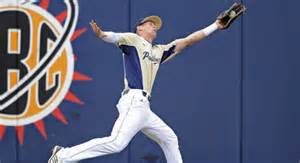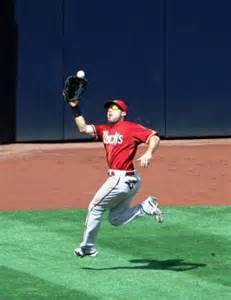Tracking Fly Balls
Tracking fly balls is one of the most important skills an outfielder must learn in order to successfully play the outfield. Tracking the ball simply means taking the most direct route to where the ball will land.
It is quite common for an inexperienced outfielder to take the wrong route to a fly ball, running more of a zig-zag route as he constantly adjusts his path to the ball. Why is this? Most teams do not hit enough practice fly balls to their outfielders and as with all learned skills, practice is one of the essential ingredients for gaining ‘tracking’ experience.
Here are some tips and drills for you to use in practice to help players develop this critical skill.

The first thing to teach is how to run as bad running techniques sabotages their chance of making the catch.
1. Runners must run on the balls of their feet, not their heels. Running on their heels makes their head and eyes move making tracking the ball quite difficult, while the eyes are still and steady when running on the balls of the feet.
2. Running involves the swinging of the arms. The problem is some players fail to feel the glove is part of their body, therefore they either don’t swing their glove arm, or worse yet, run with it extended outward. This slows the player down and restricts his flexibility. The glove should be raised, for the catch, the last 3 or 4 steps before reaching the ball.
3. The ability to get a “Good Jump” on the ball can make the difference between catching the ball, or missing it by a few inches as it passes by you to the wall. There are a couple of basic elementary issues which need to be learned.

Drop Step - Tracking Fly Balls
a. The player must be moving prior to the ball being hit. It’s faster to redirect energy, changing direction, that initiating energy, starting to move after the ball is hit.
b. The player must anticipate the flight of the ball. This skill increases with experience, but the key is intently watching every pitch to the plate. A pitch jamming a hitter will most likely be pulled, the opposite for a ball on the outside of the plate.
c. Watching the action of the bat and the batter’s body language is another aspect to observe. A mighty swing, but the batter slamming his bat into the ground, means lack of solid contact and a lazy fly ball, not a towering blast.

Good Anticipation-Tracking Fly Balls
Tracking Fly Balls: Tips & Drills
1. A coach must teach the “Drop Step.” Ball hit to the outfielder’s left, drop step with left foot, turn and run, hit to right side, drop right leg, turn and run. Never allow a player to “Back Pedal” … Turning the wrong way every once in a while will most likely result in failure to catch the ball, but back pedaling with result in failure 99% of the time.
2. Develop instinct. Hit fly balls over and to the sides of the players. Have them run to the spot they think the ball will land. They are Not to look for the ball until only a few feet from where they think it’ll land. Catching the ball is very important, but building confidence and instinct is the key to this drill.
1. Have your outfielders break on every hit while taking batting practice. For example, the left fielder should break and run a couple of steps towards the ball even though the ball is hit to right field.
2. For older players it’s always important to know the slice of the ball in order to help track it. Example, a centerfielder must know a ball, especially a line drive type hit, will fade/slice/spin away from him. Hit to right center will slice to the right fielder, left to the left fielder. This is very important when calling someone off the ball, only to have it tail away out of reach.
Remember … there is no substitute for experience. Hit fly balls to your outfielders until you’re exhausted, as it will pay big dividends in the future.
Tracking Fly Balls to Outfield Play

New! Comments
Have your say about what you just read! Leave me a comment in the box below.